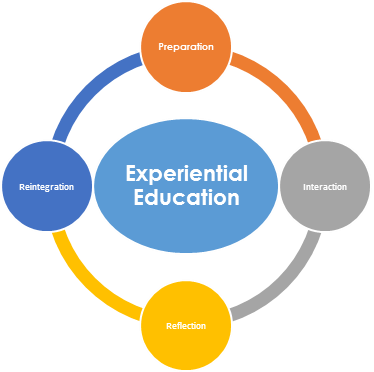- Referred to as “learning by doing”
- This is a process of actively involving students in an authentic experience that will have advantages and drawbacks.
- This includes students making discoveries and experiment with knowledge themselves instead of listening or reading about the experiences of others.
- Students also reflect on their experiences, thus enhancing new skills, new attitudes, and new theories or ways of thinking. Experiential education is related to the constructivist learning theory.
Changes in Roles and Structures
The main idea is to involve student voice in active roles for the purpose of learning. Teachers may implement experiential education in cultural journalism, service learning, environmental education, or more traditional school subjects.
Some experts in the field make the distinction between “democratic experiential education” in which students help design curricula and run their own projects and even do their own grading (through objective contracted standards) and other forms of “experiential education” that put students in existing organizations in inferior roles (such as service learning and internships) or in which faculty design the field work.
Experiential learning uses numerous tools like games, simulations, role plays, stories in classrooms. The experiential learning outlook changes the way the teachers and students view knowledge. Knowledge is no longer just some letters on a page. It becomes active, something that is transacted with in life or life-like situations. It starts to make teachers experience providers, and not just transmitters of the written word. Students become knowledge creators (for themselves) as well as knowledge gatherers.
Aside from changing student roles, experiential education needs a change in the role of teachers. When students are active learners, their accomplishments often take them outside the classroom walls. Because action precedes attempts to synthesize knowledge, teachers generally cannot plan a curriculum unit as a neat, predictable package. Teachers become active learners, too, experimenting together with their students, reflecting upon the learning activities they have designed, and responding to their students’ reactions to the activities. In this way, teachers themselves become more active; they come to view themselves as more than just recipients of school district policy and curriculum decisions.
As students and teachers take on new parts, the traditional organizational structures of the school also may meet challenges. For example, at the Challenger Middle School in Colorado Springs, Colorado, service activities are an essential part of the academic program. Such nontraditional activities require teachers and administrators to perceive at traditional practices in new ways. For instance, they may consider reorganizing time blocks. They may also teach research methods by involving students in investigations of the community, rather than restricting research activities to the library.
At the University Heights Alternative School in the Bronx, the Project Adventure experiential learning program has led the faculty to adopt an all-day time block as an alternative to the traditional 45-minute periods. The faculty now organizes the curriculum by project instead of by separate disciplines. Schools that promote meaningful student participation actively engage students as partners in education improvement activities. These young people learn while planning, researching, teaching, and making decisions that affect the entire education system.
At the university level, including universities like Stanford and the University of California Berkeley, students are often the originators of courses and demand more role in changing the curriculum and making it truly responsive to their needs. In some cases, universities have offered alternatives for student-designed faculty approved courses. In other cases, students have formed movements or even their own NGOs like Unseen America Projects, Inc., to endorse democratic experiential learning and to design and accredit their own alternative curricula.
Other university level programs are entirely field-taught on outdoor expeditions. These courses combine traditional academic readings and written assignments with field observations, service projects, open discussions of course material, and meetings with local speakers who are involved with the course subjects. These “hybrid” experiential/traditional programs aim to provide the academic rigor of a classroom course with the breadth and personal connections of experiential education.
